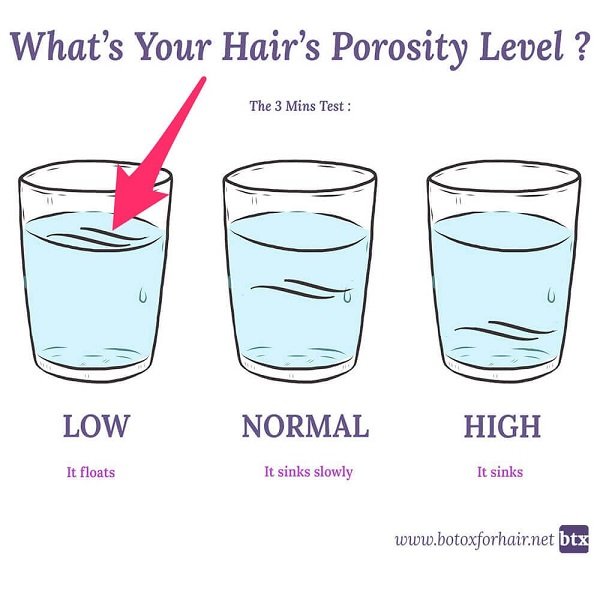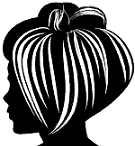Low porosity hair can be a challenge to care for, as it often requires a different approach than other hair types. If you have low-porosity hair, you may have noticed that your hair doesn’t absorb moisture easily and can feel dry and brittle. However, with a proper hair care routine for low-porosity hair tailored to your specific needs, you can achieve healthy, moisturized hair. In this article, we’ll explore the best practices for caring for low-porosity hair and share tips and tricks for achieving your best hair yet.
low porosity hair
Low porosity can exist in any hair texture: straight, curly, fine, or thick strands. The characteristic of low-porosity hair is that it does not absorb moisture as much as hair with higher porosity.
It’s also much more slippery, meaning it can be harder to get grip and volume.
Having low porosity means that the cuticle of your strands is tightly bonded, stays flat, and tends to repel water. In general, low-porosity hair tends to be shiny and more resistant to chemical processes.
How do I know if I have low porous hair?

People with low porosity hair often feel like their hair behaves differently and doesn’t adapt very well to “conventional hair wisdom.” If you have low-porous hair, you’ve probably noticed that products often seem to “sit” on top of your hair instead of absorbing. You may notice that your hair takes longer to soak through when you shower and that it takes several hours (or even days) to dry completely after washing. People with low-porosity hair often find themselves with dry, straw-like, and dull hair, despite using moisturizing treatments and avoiding sulfates. If this is the case with your hair, try one of the simple at-home hair porosity tests.
What should I do if my hair has low porosity?
Low-porosity hair tends to look smooth and shiny. Although it is easy to hydrate and take good care of low-porous hair, it is preferable to follow some tricks.
▸ Tricks to care for low-porosity hair:

Broadly speaking, the products suitable for this type of porosity must be water-based and lightweight. These ingredients are water and other humectant-type components such as herbal extracts, aloe vera, or honey.
To identify that a product is water-based, look to see that water appears first in the list of ingredients: aqua, water.
The light oils that low porosity hair prefers are usually:
- Coconut oil.
- From grape seeds.
- The jojoba one.
- Argan oil.
- Sweet almonds.
- From hemp seeds.
- Pomegranate seed oil.
- From apricot seeds.
Our curls’ favorite oils and butter are usually coconut oil and shea butter.
How to hydrate low-porosity hair?
We can do it in several different ways:
- Using a conditioner after washing it with shampoo and hot water.
- Applying a deep hydration treatment with maintained heat.
The hair will thus be able to benefit from the properties of the ingredients at the right time and in the right measure.
The frequency of use of heat-applied treatments is between one and three times a month. But this is something that each person has to evaluate according to how they notice their hair at all times, it is a matter of trying and observing the results.
The heat acts when it gently opens the cuticles so that the nutrients from the treatments and conditioners penetrate the low-porosity hair fiber.
I’ll tell you how to do it: apply moderate heat with a hairdryer, with your hair covered with a plastic cap, for 10–15 minutes; although the ideal is to follow the manufacturer’s instructions.
Proper hair care routine for low porosity hair
This type of hair is in luck!
You don’t need many products to look beautiful and healthy. Simply wash it with shampoo and conditioner regularly.
If your hair is long, use your favorite detangler. And to finish marking the curl, a light amount of styling cream or styling gel, and you’re ready.
Do not overload your hair with the product, or you will quickly notice it is dull, heavy, and less defined.
Tips for hair care routine for low porosity hair

- Oil your hair regularly. If your hair tends to be dry, oil it every other day.
- While oiling your hair, be sure to massage your scalp. This improves circulation and hair thickness.
- Use deep conditioning treatments at least once a week.
- Use hair products that are specifically made for low-porosity hair.
- Avoid using chemical treatments and heating tools for some time, as they can strip moisture from your hair, leaving it dry and damaged.
What you should avoid if you have hair with low porosity?
- Avoid using cold water to wash your hair. Using warm or hot water helps open the cuticle and allows hydration to enter.
- Avoid completely air drying. Low porosity hair takes a long time to dry and the water it retains weighs down the strands, which stretches the curls. Try plopping to let the towel or t-shirt absorb some of the water and the curls settle.
Choosing the right products for hair care routine for low-porosity hair

Choosing the right hair products is essential for maintaining healthy, moisturized low porosity hair. Here are some tips to help you choose the right products for your hair:
- Look for lightweight products: Heavy products can weigh down low-porosity hair and make it look greasy. Look for lightweight products that won’t leave your hair feeling heavy or oily.
- Use water-based products: Low-porosity hair doesn’t absorb moisture easily, so it’s important to use water-based products that can penetrate the hair shaft. Look for products that list water as one of the first ingredients.
- Avoid protein-heavy products: While protein is important for maintaining healthy hair, too much protein can make low-porosity hair feel stiff and dry. Look for products that contain a balanced amount of protein.
- Use leave-in conditioners: Leave-in conditioners can help moisturize low-porosity hair throughout the day. Look for leave-in conditioners that are lightweight and won’t weigh down your hair.
- Experiment with different products: Everyone’s hair is different, so it may take some trial and error to find the right products for your low-porosity hair. Don’t be afraid to experiment with different products until you find what works best for you.
By choosing the right products for your low-porosity hair, you can help to keep your hair healthy, moisturized, and looking its best.
conclusion
In conclusion, a proper hair care routine is crucial for maintaining healthy and moisturized low-porosity hair. Understanding the unique characteristics of low-porosity hair and implementing the right practices can make a significant difference in the overall health and appearance of your hair.
Throughout this article, we have explored various tips and techniques specifically tailored to low-porosity hair. From using warm water during washing to incorporating regular deep conditioning and clarifying, these practices can help open up the hair cuticles and allow moisture to penetrate more effectively.
Choosing the right products for low-porosity hair is equally important. Opting for lightweight, water-based products and avoiding protein overload can help maintain the moisture balance and prevent dryness or heaviness.
Remember, finding the perfect hair care routine for low-porosity hair may require some experimentation and adjustments. Each individual’s hair is unique, so it’s essential to listen to your hair’s needs and adapt accordingly.
By following these guidelines and customizing your hair care routine, you can achieve healthy, nourished, and vibrant low-porosity hair. Embrace the journey of discovering what works best for your hair, and enjoy the beauty and confidence that comes with well-cared-for locks.
you may be interested in
Natured your relaxed: Daily hair care routine for relaxed hair
Explore Best hair care routine for dry frizzy hair
Best hair care routine for colored hair
FAQ
Low-porosity hair is also known as protein-sensitive hair. A protein treatment every 6 weeks and 1-3 deep hydrating conditioners per month should work well for this hair type.
One of the best proteins for low-porosity hair is hydrolyzed wheat protein oil. It has a small enough molecule structure to enter low-porosity hair strands, but a large enough molecule size to coat and protect hair strands.
Some so-called “light” oils such as grape seed, jojoba or sweet almond oil are well suited to low-porous hair. They protect the hair without suffocating it or weighing it down.

